Gas Permeability Model for Porous Materials from Underground Coal Gasification Technology
Abstract
:1. Introduction
1.1. Systematics of Method of Gasification Process of Coal In Situ
1.2. Gas Movement in a Porous Structure
- (1)
- For a single porous structure, the calculations are based on models of cylindrical capillaries:
- –
- Burdini—one capillary of equal radius;
- –
- Mualema—two bound capillaries with different radii;
- –
- The specific shape of the capillary in which the skin effect occurs.
- (2)
- A double structure, in which there is a dominant gas flow through a porous matrix and fractures with negligible permeability.
- (3)
- A multiple structure, in which a transient is created in the process of gas flow from the porous matrix to the fractures; these states determine the nature of the flow over relatively long periods of time (years).
- –
- Subcapillary—movement takes place only at increased temperature and pressure;
- –
- Capillary—movement occurs under the influence of capillary forces and surface tension;
- –
- Hypercapillary—motion according to the general laws of hydraulics and under the action of gravity.
- –
- Laminar flow occurs when the collisions of molecules occur in frequently changing capillary radii;
- –
- Diffusion—occurs as a process of self-mixing of gas particles until full equalization;
- –
- Knudsen transport—defined as the number of collisions of a molecule with the pore walls, related to the number of mutual collisions between molecules [21].
1.3. Scope and Research Methodology
2. Materials and Methods
Research Position
3. Results and Discussion
3.1. Results of Porosity and Gas Permeability
3.2. Results of Coefficient of Gas Flow Resistances
3.3. Results of Gas-Permeability Coefficient
3.4. Own Model of Coefficient of Gas Flow Resistances
4. Conclusions
- (1)
- Char (carbonizer) in situ and melted waste rock in situ research materials are characterized by a large variety of structures;
- (2)
- The structural features of materials derived from underground processing can be attributed to many porosity patterns;
- (3)
- Char (carbonizer) in situ—a fractured medium, it is more permeable in relation to melted waste rock in situ—a less-porous medium (low proportion of open pores);
- (4)
- Average transmittance does not depend on the shape of the sample, but on the internal structure;
- (5)
- The appropriate adaptation of the model equations allowed for a confrontation with the authors’ own model, pointing to the need to interpret gas permeability in an unconventional way, especially for materials derived from UCG technology.
Funding
Institutional Review Board Statement
Informed Consent Statement
Data Availability Statement
Conflicts of Interest
Abbreviations
| A | total cross-section of the flow channel | m2 |
| K | permeability coefficient | m2 |
| P | pressure gauge | Pa |
| Q | volumetric flow | m3/s |
| Re | Reynolds number | |
| T | thermometer | °C |
| V | volume | m3 |
| e | indicator porosity | |
| d | diameter | m |
| f | function | |
| w | velocity | /s |
| ΔP | pressure drop, resistance flow | Pa |
| Ψ | tortuosity | |
| ε | porosity | |
| η | fluid viscosity | Pa·s |
| ξ | coefficient of flow resistance | |
| π | Pi number | |
| ρ | fluid density | kg/m3 |
| χ | coefficient of tortuosity | |
| Upper indices refer to | ||
| a | exponent | |
| b | exponent | |
| * | own model | |
| Lower indices refer to | ||
| B | acc. Brauer | |
| B-K | acc. Blake-Kozeny | |
| B-K-C | acc. Blake-Kozeny–Carman | |
| B-P | cc. Burke-Plummer | |
| E | acc. Ergun | |
| T | acc. Tallmadge | |
| V | own model | |
| W | acc. Windsperger | |
| Z | acc. Zaworonkow | |
| a | apparent | |
| b | absolute | |
| c | total | |
| ef | effective | |
| g | gas | |
| o | value calculated on the total deposit section-apparent value | |
| r | nozzle | |
| re | reference | |
| s | skeleton | |
| zm | measured | |
| ε | value calculated relative to the porosity |
References
- Stańczyk, K.; Kapusta, K. Underground coal gasification. Karbo 2007, 2, 98–102. [Google Scholar]
- Kreinnin, E.V.; Zorya, A.Y. Underground Coal Gasification Problems. Springer Solid Fuel Chem. 2009, 43, 215–218. [Google Scholar] [CrossRef]
- Shafirovich, E.; Mastalerz, M.; Rupp, J.; Varma, A. The Potential for Underground Coal Gasification in Indiana. Phase I. Report to the Indiana Center for Coal Technology Research (CCTR); Purdue University: West Lafayette, IN, USA, 2008. [Google Scholar]
- Wałowski, G.; Filipczak, G. Technical and Technological Aspects of “In Situ” Coal Processing. In Proceedings of the XXI School of Underground Exploitation, Cracow, Poland, 20–24 February 2012; pp. 389–396. [Google Scholar]
- Younger, P.L. Hydrogeological and Geomechanical Aspects of Underground Coal Gasification and its Direct Coupling to Carbon Capture and Storage. Springer Mine Water Environ. 2011, 30, 127–140. [Google Scholar] [CrossRef]
- Stańczyk, K.; Świądrowski, J.; Kapusta, K.; Howaniec, N.; Cybulski, K.; Rogut, J.; Smoliński, A.; Wiatowski, M.; Kotyrba, A.; Krause, E.; et al. Hydrogen-Oriented Underground Coal Gasification for Europe (HUGE); EUR 25044 EN; Final Report 2012. Research Found for Coal and Steel; European Commission: Brussels, Belgium, 2012. [Google Scholar]
- Stańczyk, K.; Smoliński, A.; Kapusta, K.; Wiatowski, M.; Świądrowski, J.; Kotyrba, A.; Rogut, J. Dynamic experimental simulation of hydrogen oriented underground coal gasification of lignite. Fuel 2007, 89, 3307–3314. [Google Scholar] [CrossRef]
- Wałowski, G. Wałbrzych from the Poor Shafts to Underground Gasification of Hard Coal; Publishing House of the Catholic Action of the Archdiocese of Lublin: Lublin, Poland, 2009; ISBN 978-83927527-8-3. [Google Scholar]
- Wałowski, G. Technical Condition and Prospects for the Development of Underground Coal Gasification Technology. The Influence of Young Scientists on the Achievements of Polish Science; CREATIVETIME: Cracow, Poland, 2012. [Google Scholar]
- Wałowski, G. Nowa Ruda: From Poor Shafts to Underground Hard Coal Hydrogenation; Poligraf Publishing House: Brzezia Łąka, Poland, 2011; ISBN 978-83-62752-68-3. [Google Scholar]
- Seewald, H.; Klein, I. Methansorption an Stainkohle und Kennzeichnung der Porenstrukture. Gluckauf Forsch. 1985, 47, 149. [Google Scholar]
- Topolnicki, J.; Wierzbicki, M.; Skoczylas, N. Tests of apparatus for measuring the kinetics of CO2 release from hard coal samples. Work. Strat. Mech. Inst. PAN 2004, 6, 71–78. [Google Scholar]
- Szott, W.; Gołąbek, A. Simulations of the exploitation process of natural gas deposits in shale gas formations. Naft. Gaz 2012, 12, 923–936. [Google Scholar]
- Burdine, N.T. Relative permeability calculation from pore size distribution data. Trans. Am. Inst. Min. Eng. 1953, 198, 71–78. [Google Scholar] [CrossRef]
- Mualem, Y. Modeling the Hydraulic Conductivity of Unsaturated Porous Media, in Indirect Methods for Estimating the Hydraulic Properties of Unsaturated Soils; van Genucthen, M.T., Leij, F.J., Lund, L.J., Eds.; University of California: Riverside, CA, USA, 1992; pp. 15–36. [Google Scholar]
- Gonet, A.; Nagy, S.; Rybicki, C.; Siemek, J.; Stryczek, S.; Wiśniowski, R. Coal bed methane extraction technology (CBM). Gor. Geol. 2010, 5, 5–25. [Google Scholar]
- Krause, E.; Karbownik, M. Tests of methane desorption and emission from samples of hard coal in the context of mine closures through flooding. J. Sustain. Min. 2019, 18, 127–133. [Google Scholar] [CrossRef]
- Hagoort, J. Fundamentals of Gas Reservoir Enginnering. Developments in Petroleum Science 23; Elsevier: Amsterdam, The Netherlands, 1988. [Google Scholar]
- Wyrwał, J. Moisture Movement in Porous Materials and Building Partitions, WSI in Opole, Studies and Monographs; WSI: Opole, Poland, 1989; p. 31. [Google Scholar]
- Werner, H.; Gertis, K. Energetische Kopplung von Feuchte- und Wärmeübertragung an Außenflächen; Hygrische Transportphänomene in Baustoffen, Deutscher Ausschuß für Stahlbeton: Berlin, Germany, 1976; Volume 258. [Google Scholar]
- Pogorzelski, J. Thermal Physics of Buildings; PWN: Warsaw, Poland, 1976. [Google Scholar]
- Busch, A.; Gensterblum, Y.; Krooss, B.M.; Littke, R. Methane and carbon dioxide adsorption–diffusion experiments on coal: Upscaling and modeling. Int. J. Coal Geol. 2004, 60, 151–168. [Google Scholar] [CrossRef]
- Bustin, R.M.; Bustin, A.M.M.; Cui, A.; Ross, D.; Pathi, V.M. Impact of Shale Properties on Pore Structure and Storage Characteristics. Presented at the SPE Shale Gas Production Conference, Fort Worth, TX, USA, 16–18 November 2008. Paper Number: SPE-119892-MS. [Google Scholar] [CrossRef]
- Mastalerz, M.; He, L.; Melnichenko, Y.B.; Rupp, J.A. Porosity of coal and shale: Insights from gas adsorption and SANS/USANS techniques. Energy Fuels 2012, 26, 5109–5120. [Google Scholar] [CrossRef]
- Karayiğit, A.İ.; Mastalerz, M.; Oskay, R.G.; Gayer, R.A. Coal petrography, mineralogy, elemental compositions and palaeoenvironmental interpretation of Late Carboniferous coal seams in three wells from the Kozlu coalfield (Zonguldak Basin, NW Turkey). Int. J. Coal Geol. 2018, 187, 54–70. [Google Scholar] [CrossRef]
- Karayigit, A.İ.; Bircan, C.; Oskay, R.G.; Türkmen, İ.; Querol, X. The geology, mineralogy, petrography, and geochemistry of the Miocene Dursunbey coal within fluvio-lacustrine deposits, Balıkesir (Western Turkey). Int. J. Coal Geol. 2020, 228, 103548. [Google Scholar] [CrossRef]
- Liu, X.; Nie, B.; Wang, W.; Wang, Z.; Zhang, L. The use of AFM in quantitative analysis of pore characteristics in coal and coal-bearing shale. Mar. Pet. Geol. 2019, 105, 331–337. [Google Scholar] [CrossRef]
- Ergun, S. Fluid flow through packed columns. Chem. Eng. Prog. 1952, 48, 89–94. [Google Scholar]
- Brauer, H. Grundlagen der Einphasen—Und Mehrphasenströmungen; Säuerländer: Frankfurt am Main, Germany, 1971. [Google Scholar]
- Tallmadge, J.A. Packed bed pressure drop—An extension to higher Reynolds numbers. AIChE J. 1970, 16, 1092–1093. [Google Scholar] [CrossRef]
- Burke, S.P.; Plummer, W.B. Gas Flow through Packed Columns. Ind. Eng. Chem. 1928, 20, 1196–1200. [Google Scholar] [CrossRef]
- Kembłowski, Z.; Michałowski, S.; Strumiłło, C.; Zarzycki, R. Theoretical Foundations of Chemical and Process Engineering; WNT: Warszawa, Poland, 1985. [Google Scholar]
- Zaworonkow, M.N. Gidrawliczeskije Osnowy Skrubbernogo Processa i Tiepłopieredacza w Skrubberach; Izd. Sow. Nauka: Moscow, Russia, 1944. (In Russian) [Google Scholar]
- Windsperger, A. Abschätzung von spezifischer Oberfläche und Lückengrad bei biologischen Abluftreinigungsanlagen durch Vergleich von berechneten und experimentell erhaltenen Druckverlustwerten. Chem. Eng. Technol. 1991, 63, 80–81. [Google Scholar] [CrossRef]
- Peszyńska, M.; Trykozko, A. Pore-to-Core simulations of flow with large velocities using continuum models and imaging data. Comput. Geosci. 2013, 17, 623–645. [Google Scholar] [CrossRef]
- Bear, J.; Cheng, A. Modeling Groundwater Flow and Contaminant Transport; Springer: New York, NY, USA, 2010. [Google Scholar]
- Wałowski, G. Model of Flow Resistance Coefficient for a Fragment of a Porous Material Deposit with Skeletal Structure. Energies 2021, 14, 3355. [Google Scholar] [CrossRef]

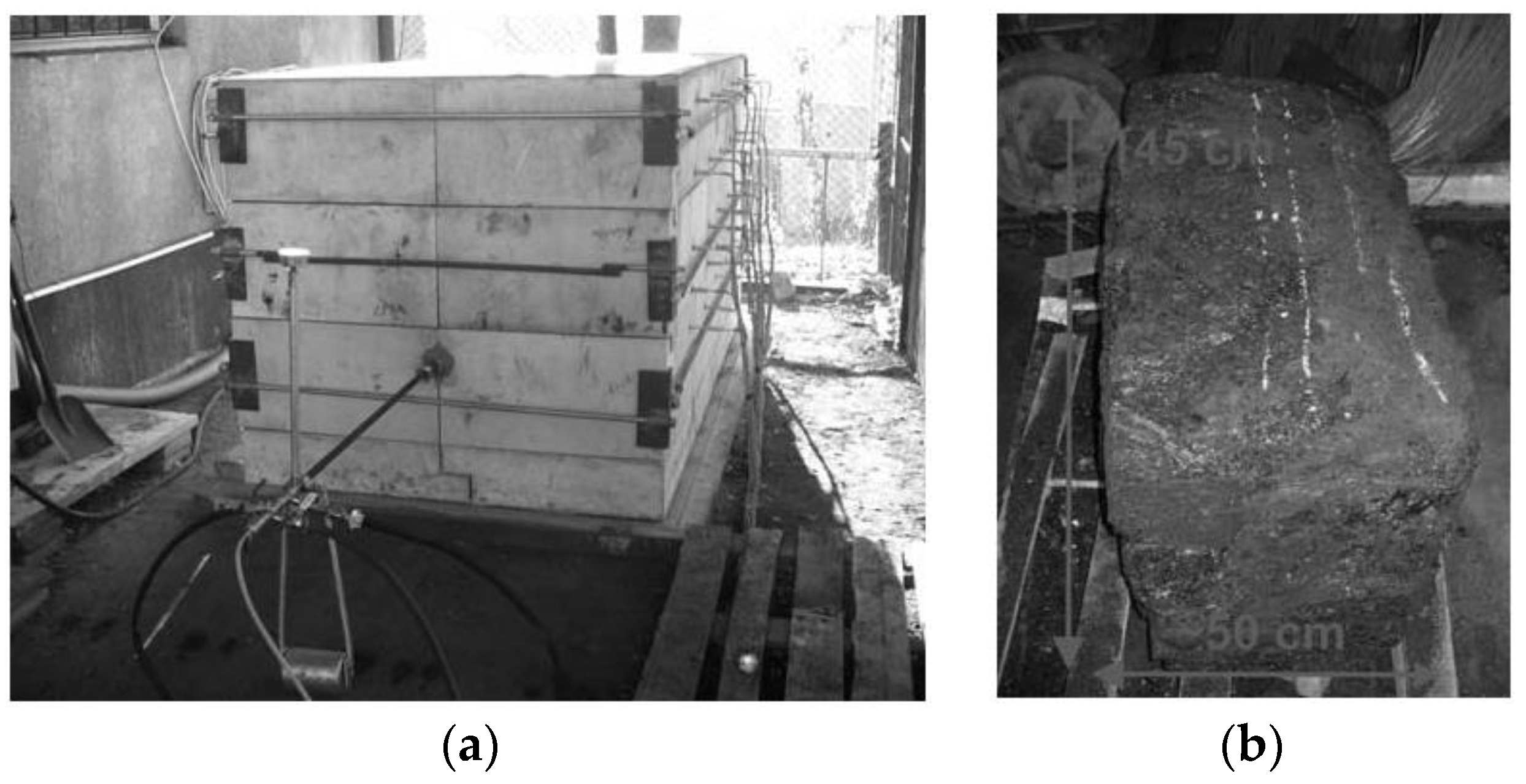






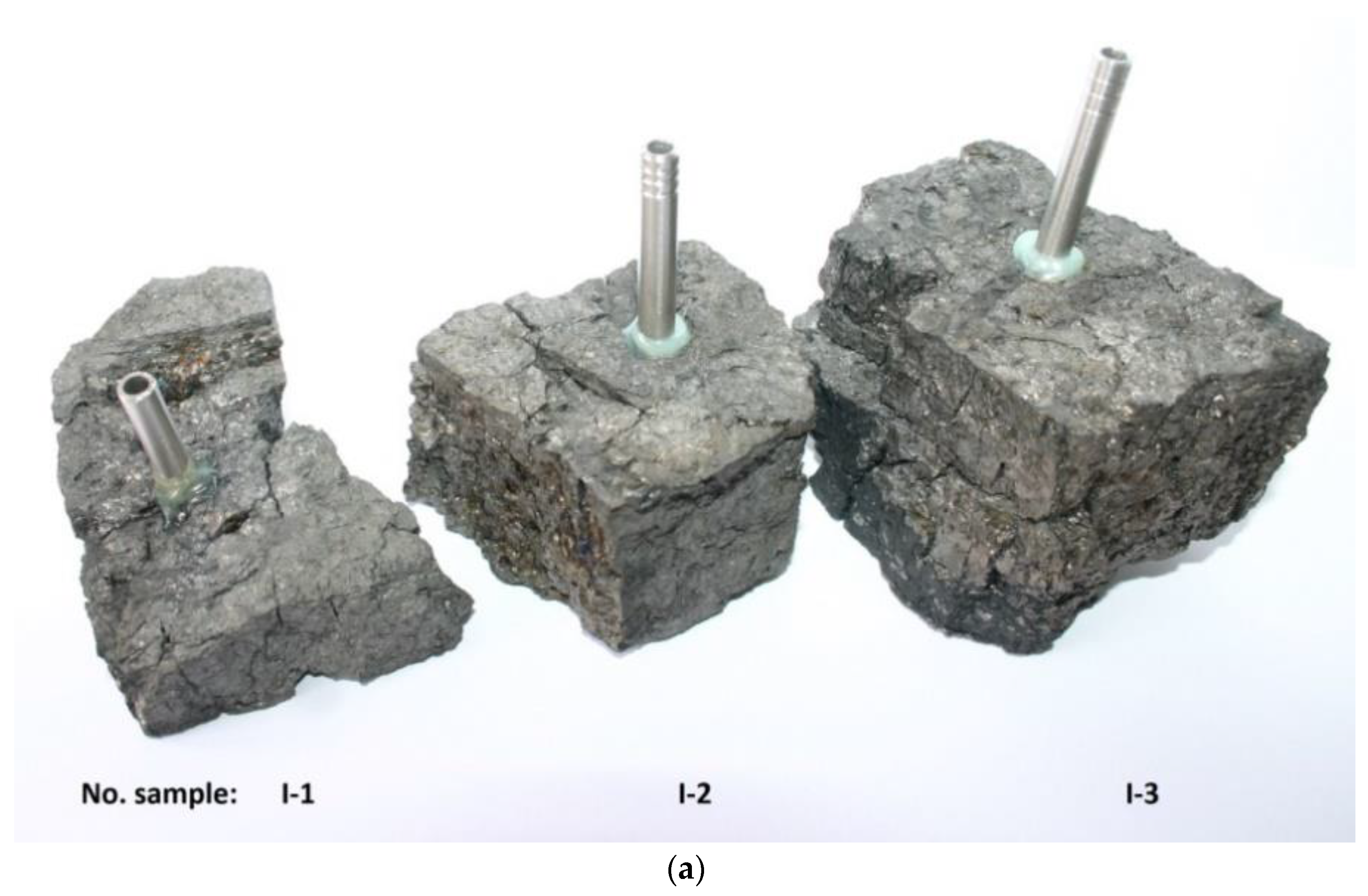
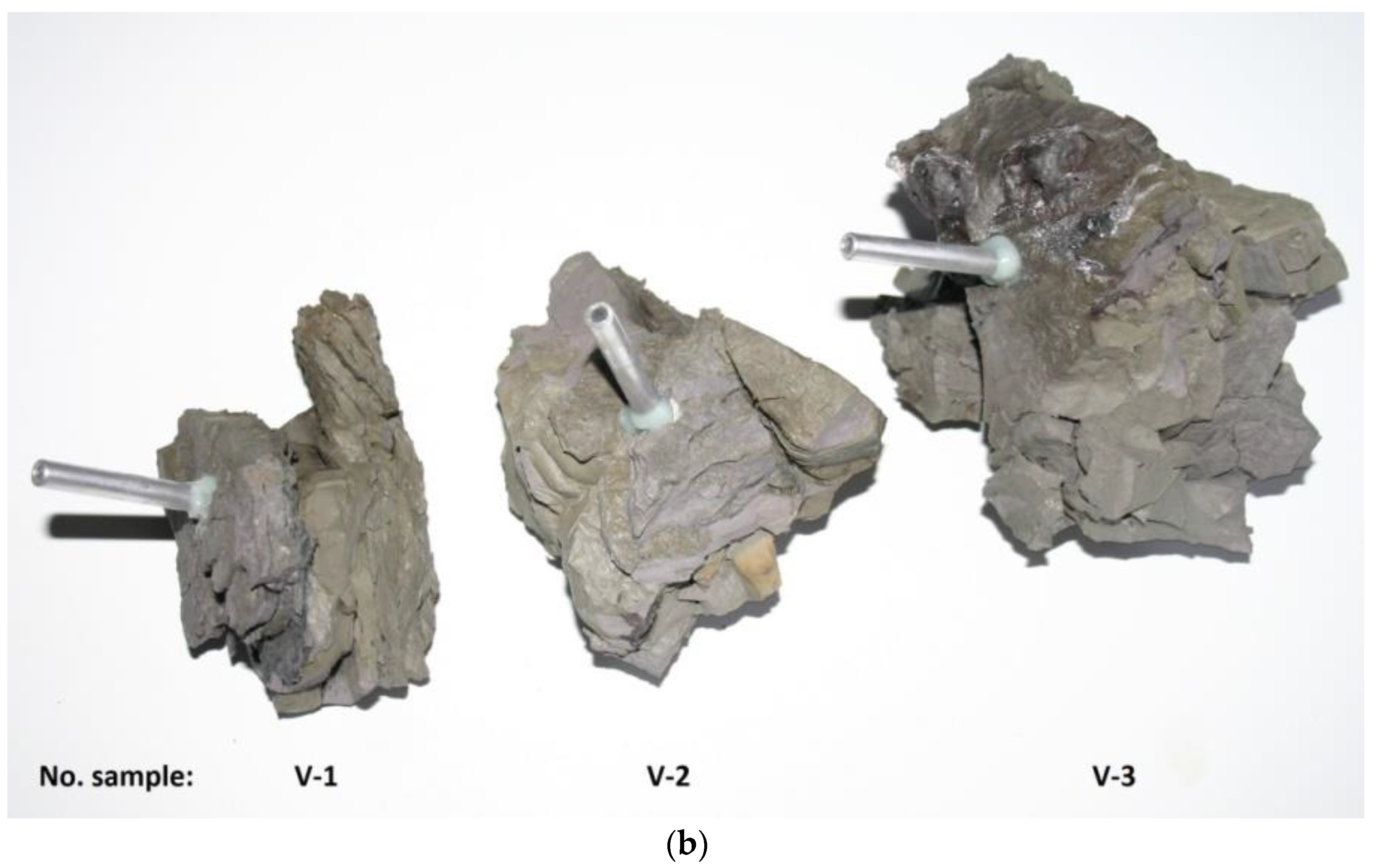

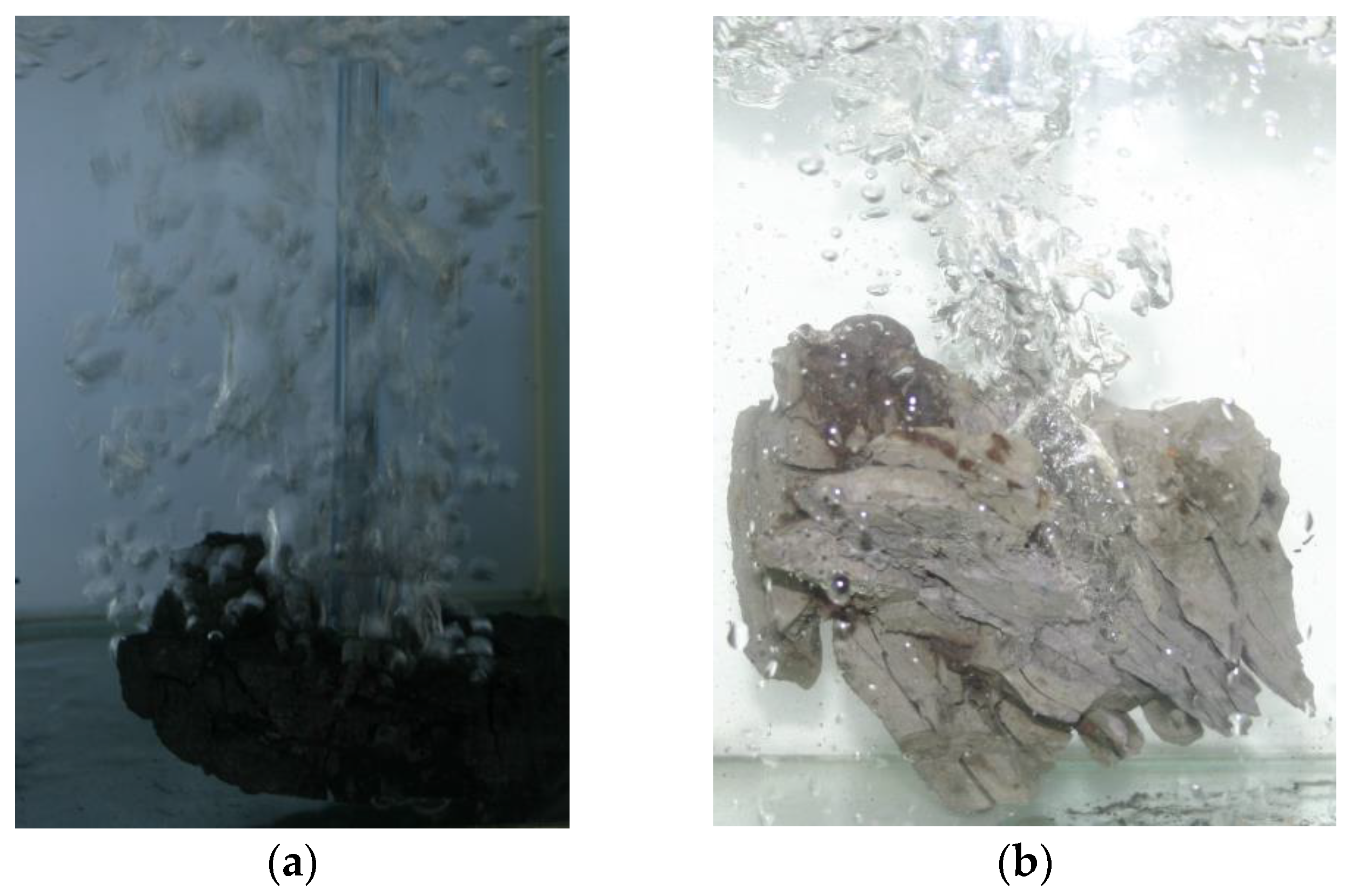
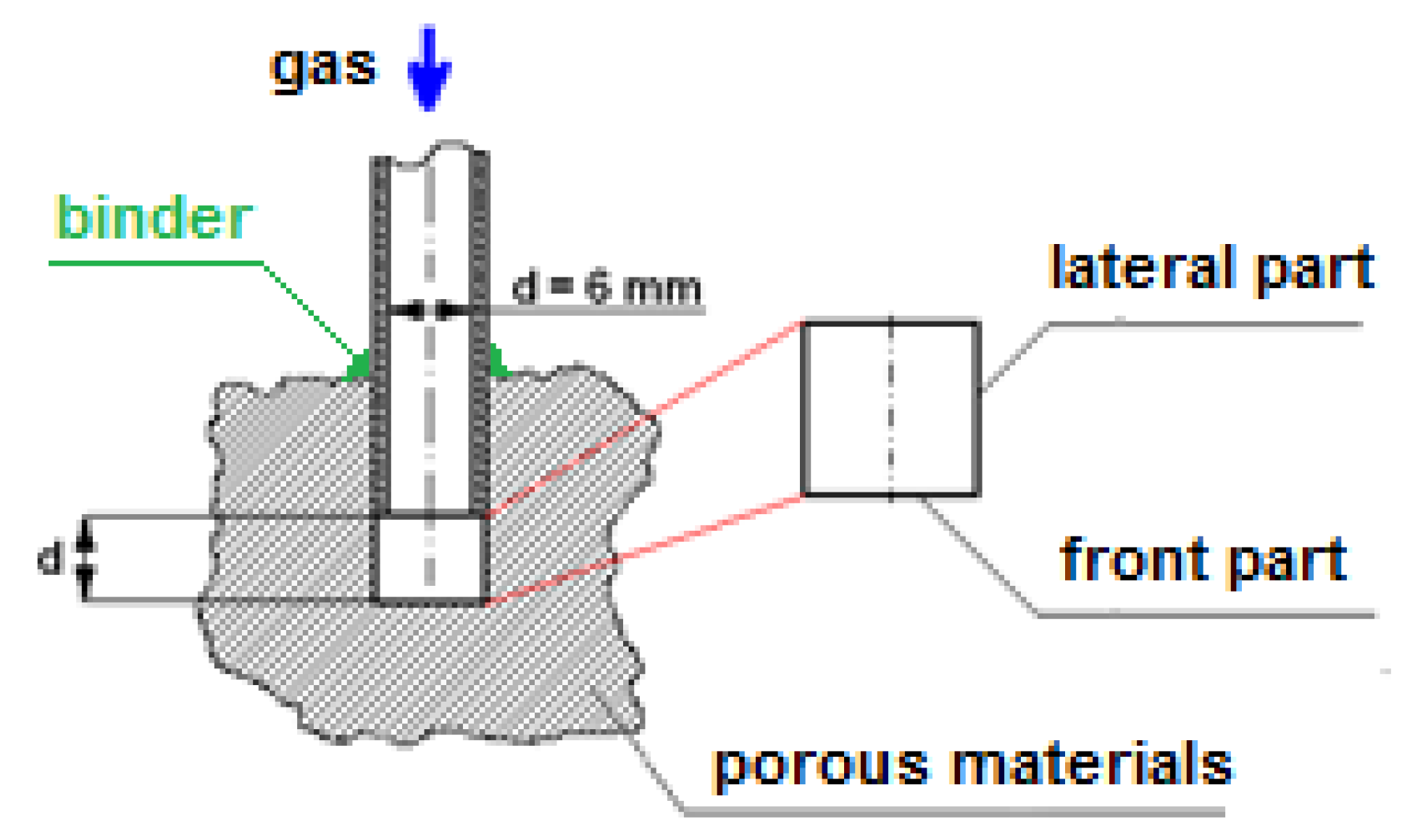
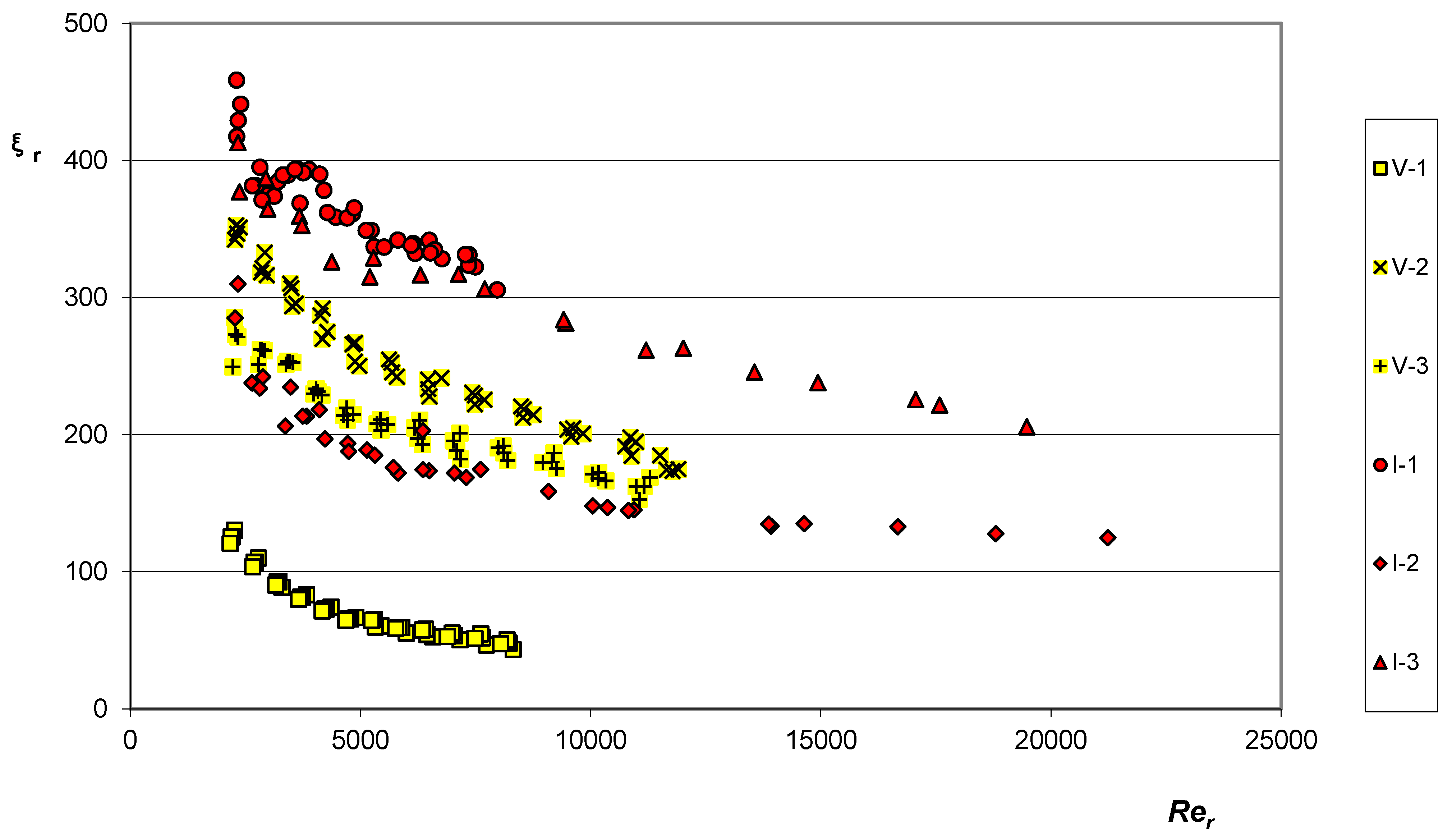
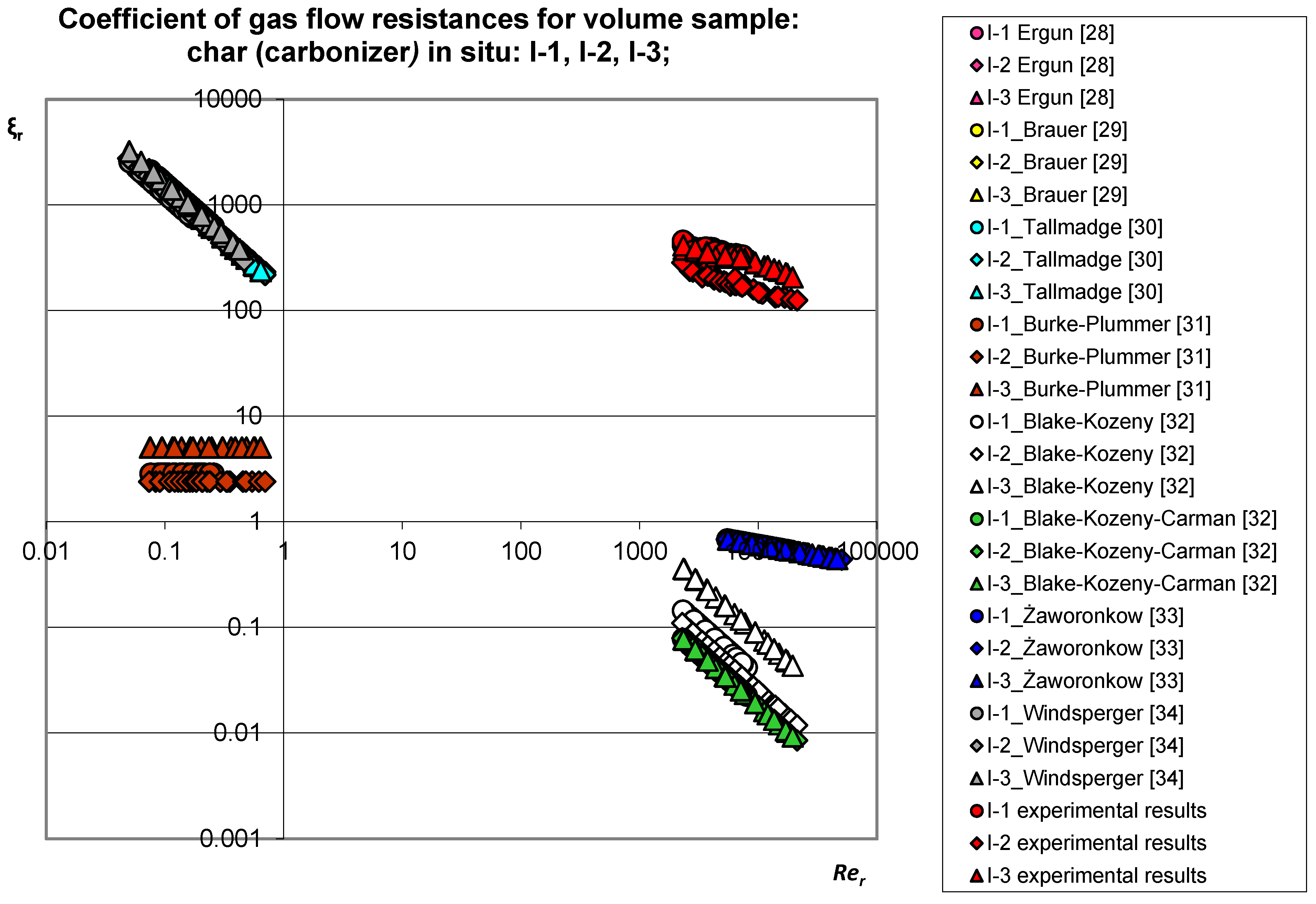


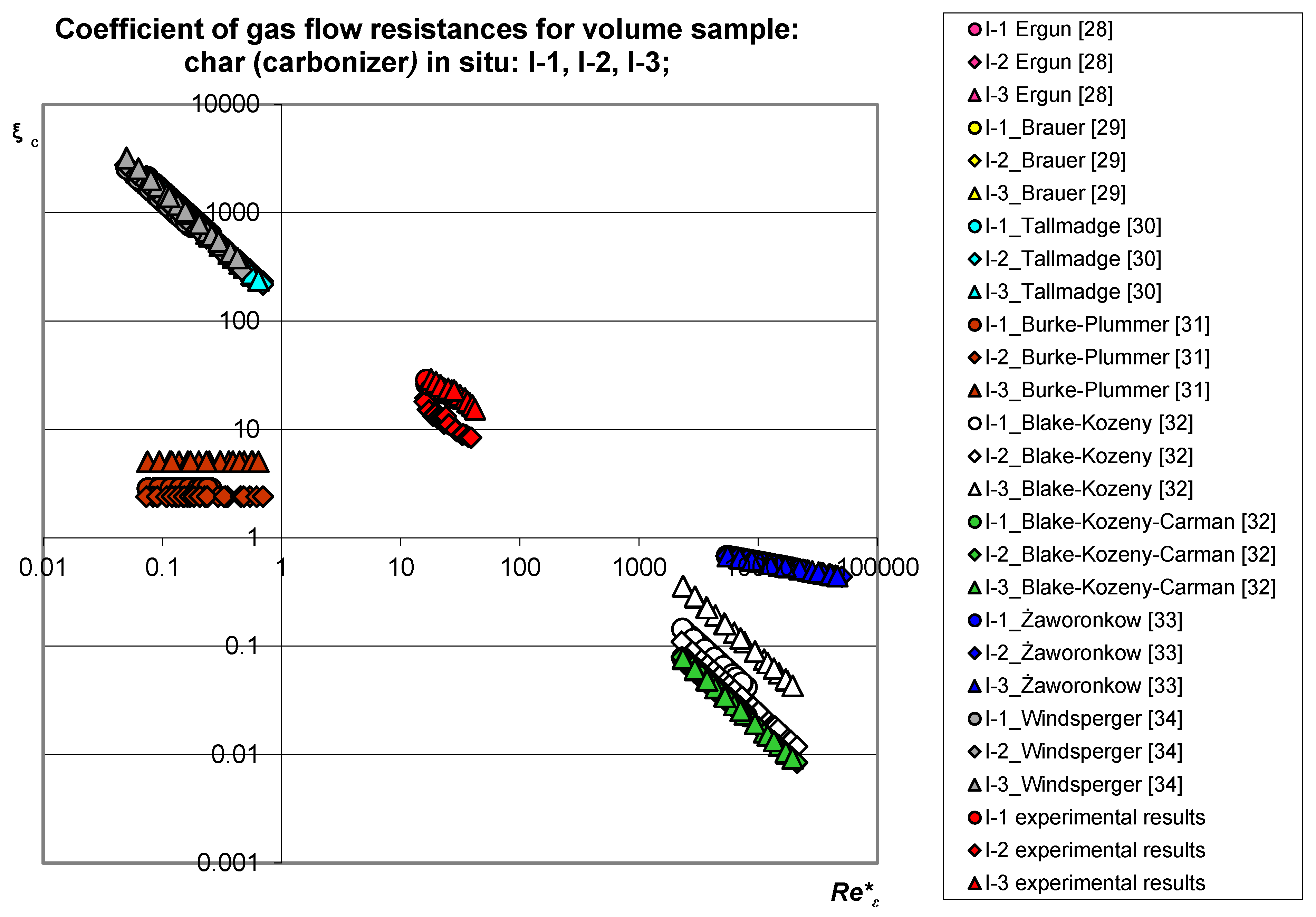
| Underground Coal Gasification | |||||
|---|---|---|---|---|---|
| Method of processing | Process holes | Channel | Technique | ||
| Injective (inflow) | Productive (outflow) | Conective | |||
| Shaft | Vertical | Horizontal | Streamline | ||
| Vertical | Drooping | Point | |||
| Horizontal | Horizontal | Vertical | Open | ||
| Horizontal | Blind | ||||
| Un-shaft | Directional | Vertical | Pointing | CRIP (I) | |
| Vertical | Vertical (ignition) | Vertical | Horizontal | CRIP (II) “Knife edge” | |
| Material (Designation and Source Origin of Raw Material) | Porosity | Indicator Porosity | Density | |||
|---|---|---|---|---|---|---|
| Absolute | Effective | Apparent | Skeleton | |||
| Name | No. Sample | εb, % | εef, % | e | ρa, kg/m3 | ρs, kg/m3 |
| char (carbonizer) in situ KD Barbara, Mikolow | I-1 | 42.2 | 21.1–33.7 | 0.7 | 1300 | 2250 |
| I-2 | 44.9 | 22.5–35.9 | 0.8 | 1239 | ||
| I-3 | 33.9 | 17.0–27.1 | 0.5 | 1487 | ||
| I-average | 40.3 | 20.2–32.2 | 0.7 | 1342 | 2250 | |
| melted waste rock in situ KD Barbara, Mikolow | V-1 | 15.4 | 7.7–12.3 | 0.2 | 1438.4 | 1700 |
| V-2 | 36.4 | 18.2–29.1 | 0.6 | 1080.8 | ||
| V-3 | 42.8 | 21.4–34.2 | 0.7 | 973.0 | ||
| V-average | 31.5 | 15.8–25.2 | 0.5 | 1164.1 | 1700 | |
| Research Material: Char (Carbonizer) in Itu KD Barbara, Mikolow No. Sample: I-1 | |||||||
|---|---|---|---|---|---|---|---|
| No. | Reference Pressure Pre, MPa | Gas Stream Qg∙103, m3/s | Resistance Flow Measured ΔPzm, kPa | No. | Reference Pressure Pre, MPa | Gas Stream Qg∙103, m3/s | Resistance Flow Measured ΔPzm, kPa |
| 1 | 0.1 | 0.161 | 10.241 | 26 | 0.3 | 0.161 | 9.709 |
| 2 | 0.1 | 0.182 | 11.305 | 27 | 0.3 | 0.182 | 11.305 |
| 3 | 0.1 | 0.196 | 12.901 | 28 | 0.3 | 0.217 | 16.625 |
| 4 | 0.1 | 0.203 | 13.832 | 29 | 0.3 | 0.238 | 20.482 |
| 5 | 0.1 | 0.217 | 16.625 | 30 | 0.3 | 0.259 | 23.940 |
| 6 | 0.1 | 0.231 | 17.955 | 31 | 0.3 | 0.287 | 29.393 |
| 7 | 0.1 | 0.238 | 20.615 | 32 | 0.3 | 0.315 | 33.516 |
| 8 | 0.1 | 0.266 | 23.940 | 33 | 0.3 | 0.350 | 44.023 |
| 9 | 0.1 | 0.280 | 27.265 | 34 | 0.3 | 0.371 | 51.205 |
| 10 | 0.1 | 0.301 | 29.925 | 35 | 0.3 | - | - |
| 11 | 0.1 | 0.329 | 37.905 | 36 | 0.3 | - | - |
| 12 | 0.1 | 0.350 | 42.826 | 37 | 0.3 | - | - |
| 13 | 0.1 | 0.371 | 49.210 | 38 | 0.3 | - | - |
| 14 | 0.2 | 0.161 | 9.75 | 39 | 0.4 | 0.161 | 10.640 |
| 15 | 0.2 | 0.189 | 12.635 | 40 | 0.4 | 0.196 | 12.768 |
| 16 | 0.2 | 0.210 | 15.295 | 41 | 0.4 | 0.231 | 19.285 |
| 17 | 0.2 | 0.231 | 19.285 | 42 | 0.4 | 0.266 | 24.206 |
| 18 | 0.2 | 0.252 | 23.275 | 43 | 0.4 | 0.301 | 31.255 |
| 19 | 0.2 | 0.280 | 26.999 | 44 | 0.4 | 0.336 | 39.900 |
| 20 | 0.2 | 0.301 | 31.255 | 45 | 0.4 | 0.350 | 43.624 |
| 21 | 0.2 | 0.322 | 36.176 | 46 | 0.4 | 0.371 | 51.205 |
| 22 | 0.2 | 0.336 | 38.969 | 47 | 0.4 | - | - |
| 23 | 0.2 | 0.343 | 42.826 | 48 | 0.4 | - | - |
| 24 | 0.2 | 0.371 | 49.476 | 49 | 0.4 | - | - |
| 25 | 0.2 | 0.392 | 53.466 | 50 | 0.4 | - | - |
| Research material: Char (carbonizer) in situ KD Barbara, Mikolow No. Sample: I-2 | |||||||
| No. | Reference Pressure Pre, MPa | Gas Stream Qg∙103, m3/s | Resistance Flow Measured ΔPzm, kPa | No. | Reference Pressure Pre, MPa | Gas Stream Qg∙103, m3/s | Resistance Flow Measured ΔPzm, kPa |
| 1 | 0.1 | 0.161 | 7.448 | 26 | 0.3 | 0.378 | 28.196 |
| 2 | 0.1 | 0.182 | 7.315 | 27 | 0.3 | 0.427 | 30.324 |
| 3 | 0.1 | 0.196 | 8.512 | 28 | 0.3 | 0.539 | 46.683 |
| 4 | 0.1 | 0.231 | 11.305 | 29 | 0.3 | 0.553 | 49.210 |
| 5 | 0.1 | 0.252 | 12.236 | 30 | 0.3 | 0.637 | 66.633 |
| 6 | 0.1 | 0.266 | 13.965 | 31 | 0.3 | 0.686 | 85.386 |
| 7 | 0.1 | 0.301 | 15.960 | 32 | 0.3 | - | - |
| 8 | 0.1 | 0.322 | 17.955 | 33 | 0.3 | - | - |
| 9 | 0.1 | 0.357 | 20.349 | 34 | 0.3 | - | - |
| 10 | 0.1 | 0.385 | 24.472 | 35 | 0.3 | - | - |
| 11 | 0.1 | 0.427 | 31.654 | 36 | 0.3 | - | - |
| 12 | 0.1 | - | - | 37 | 0.3 | - | - |
| 13 | 0.1 | - | - | 38 | 0.3 | - | - |
| 14 | 0.2 | 0.161 | 6.916 | 39 | 0.4 | 0.532 | 45.486 |
| 15 | 0.2 | 0.196 | 8.246 | 40 | 0.4 | 0.637 | 67.830 |
| 16 | 0.2 | 0.231 | 9.975 | 41 | 0.4 | 0.651 | 73.283 |
| 17 | 0.2 | 0.252 | 12.236 | 42 | 0.4 | 0.728 | 99.085 |
| 18 | 0.2 | 0.280 | 13.965 | 43 | 0.4 | 0.763 | 114.513 |
| 19 | 0.2 | 0.308 | 16.226 | 44 | 0.4 | - | - |
| 20 | 0.2 | 0.336 | 19.285 | 45 | 0.4 | - | - |
| 21 | 0.2 | 0.357 | 20.881 | 46 | 0.4 | - | - |
| 22 | 0.2 | 0.385 | 24.605 | 47 | 0.4 | - | - |
| 23 | 0.2 | 0.413 | 28.595 | 48 | 0.4 | - | - |
| 24 | 0.2 | 0.490 | 39.900 | 49 | 0.4 | - | - |
| 25 | 0.2 | 0.553 | 49.343 | 50 | 0.4 | - | - |
| Research material: Char (carbonizer) in situ KD Barbara, Mikolow No. Sample: I-3 | |||||||
| No. | Reference Pressure Pre, MPa | Gas Stream Qg∙103, m3/s | Resistance Flow Measured ΔPzm, kPa | No. | Reference Pressure Pre, MPa | Gas Stream Qg∙103, m3/s | Resistance Flow Measured ΔPzm, kPa |
| 1 | 0.1 | 0.161 | 8.911 | 26 | 0.3 | 0.308 | 30.856 |
| 2 | 0.1 | 0.196 | 12.635 | 27 | 0.3 | 0.434 | 65.436 |
| 3 | 0.1 | 0.231 | 17.556 | 28 | 0.3 | 0.490 | 86.982 |
| 4 | 0.1 | 0.266 | 21.546 | 29 | 0.3 | 0.546 | 108.661 |
| 5 | 0.1 | 0.301 | 27.664 | 30 | 0.3 | 0.588 | 128.079 |
| 6 | 0.1 | - | - | 31 | 0.3 | - | - |
| 7 | 0.1 | - | - | 32 | 0.3 | - | - |
| 8 | 0.1 | - | - | 33 | 0.3 | - | - |
| 9 | 0.1 | - | - | 34 | 0.3 | - | - |
| 10 | 0.1 | - | - | 35 | 0.3 | - | - |
| 11 | 0.1 | - | - | 36 | 0.3 | - | - |
| 12 | 0.1 | - | - | 37 | 0.3 | - | - |
| 13 | 0.1 | - | - | 38 | 0.3 | - | - |
| 14 | 0.2 | 0.161 | 9.709 | 39 | 0.4 | 0.371 | 48.146 |
| 15 | 0.2 | 0.196 | 13.433 | 40 | 0.4 | 0.525 | 99.085 |
| 16 | 0.2 | 0.238 | 18.354 | 41 | 0.4 | 0.581 | 126.350 |
| 17 | 0.2 | 0.343 | 38.703 | 42 | 0.4 | 0.623 | 140.980 |
| 18 | 0.2 | 0.385 | 50.939 | 43 | 0.4 | - | - |
| 19 | 0.2 | 0.434 | 64.505 | 44 | 0.4 | - | - |
| 20 | 0.2 | 0.476 | 77.672 | 45 | 0.4 | - | - |
| 21 | 0.2 | - | - | 46 | 0.4 | - | - |
| 22 | 0.2 | - | - | 47 | 0.4 | - | - |
| 23 | 0.2 | - | - | 48 | 0.4 | - | - |
| 24 | 0.2 | - | - | 49 | 0.4 | - | - |
| 25 | 0.2 | - | - | 50 | 0.4 | - | - |
| Research material: Melted waste rock in situ KD Barbara, Mikolow No. Sample: V-1 | |||||||
| No. | Reference Pressure Pre, MPa | Gas Stream Qg∙103, m3/s | Resistance Flow Measured ΔPzm, kPa | No. | Reference Pressure Pre, MPa | Gas Stream Qg∙103, m3/s | Resistance Flow Measured ΔPzm, kPa |
| 1 | 0.1 | 0.161 | 2.660 | 26 | 0.3 | 0.161 | 2.660 |
| 2 | 0.1 | 0.196 | 3.325 | 27 | 0.3 | 0.196 | 3.325 |
| 3 | 0.1 | 0.231 | 3.724 | 28 | 0.3 | 0.231 | 3.990 |
| 4 | 0.1 | 0.266 | 4.655 | 29 | 0.3 | 0.266 | 4.655 |
| 5 | 0.1 | 0.301 | 5.320 | 30 | 0.3 | 0.301 | 5.320 |
| 6 | 0.1 | 0.336 | 5.985 | 31 | 0.3 | 0.336 | 5.985 |
| 7 | 0.1 | 0.371 | 6.650 | 32 | 0.3 | 0.371 | 7.315 |
| 8 | 0.1 | 0.406 | 7.315 | 33 | 0.3 | 0.406 | 7.980 |
| 9 | 0.1 | 0.441 | 8.246 | 34 | 0.3 | 0.441 | 9.310 |
| 10 | 0.1 | 0.476 | 9.310 | 35 | 0.3 | 0.476 | 10.374 |
| 11 | 0.1 | 0.511 | 9.975 | 36 | 0.3 | 0.511 | 11.970 |
| 12 | 0.1 | 0.546 | 10.640 | 37 | 0.3 | 0.546 | 12.635 |
| 13 | 0.1 | - | - | 38 | 0.3 | - | - |
| 14 | 0.2 | 0.161 | 2.660 | 39 | 0.4 | 0.161 | 2.660 |
| 15 | 0.2 | 0.196 | 3.325 | 40 | 0.4 | 0.196 | 3.325 |
| 16 | 0.2 | 0.231 | 3.990 | 41 | 0.4 | 0.231 | 3.990 |
| 17 | 0.2 | 0.266 | 4.655 | 42 | 0.4 | 0.266 | 4.655 |
| 18 | 0.2 | 0.301 | 5.320 | 43 | 0.4 | 0.301 | 5.320 |
| 19 | 0.2 | 0.336 | 5.985 | 44 | 0.4 | 0.336 | 5.985 |
| 20 | 0.2 | 0.371 | 6.650 | 45 | 0.4 | 0.371 | 7.315 |
| 21 | 0.2 | 0.406 | 7.980 | 46 | 0.4 | 0.406 | 7.980 |
| 22 | 0.2 | 0.441 | 8.645 | 47 | 0.4 | 0.441 | 9.310 |
| 23 | 0.2 | 0.476 | 9.975 | 48 | 0.4 | 0.476 | 9.975 |
| 24 | 0.2 | 0.511 | 11.305 | 49 | 0.4 | 0.511 | 11.305 |
| 25 | 0.2 | 0.546 | 11.970 | 50 | 0.4 | 0.546 | 11.970 |
| Research material: Melted waste rock in situ KD Barbara, Mikolow No. Sample: V-2 | |||||||
| No. | Reference Pressure Pre, MPa | Gas Stream Qg∙103, m3/s | Resistance Flow Measured ΔPzm, kPa | No. | Reference Pressure Pre, MPa | Gas Stream Qg∙103, m3/s | Resistance Flow Measured ΔPzm, kPa |
| 1 | 0.1 | 0.161 | 7.315 | 26 | 0.3 | 0.161 | 7.448 |
| 2 | 0.1 | 0.196 | 9.975 | 27 | 0.3 | 0.196 | 10.241 |
| 3 | 0.1 | 0.231 | 13.300 | 28 | 0.3 | 0.231 | 13.965 |
| 4 | 0.1 | 0.266 | 16.891 | 29 | 0.3 | 0.266 | 18.221 |
| 5 | 0.1 | 0.301 | 20.216 | 30 | 0.3 | 0.301 | 21.945 |
| 6 | 0.1 | 0.336 | 25.403 | 31 | 0.3 | 0.336 | 26.866 |
| 7 | 0.1 | 0.371 | 32.58. | 32 | 0.3 | 0.371 | 31.255 |
| 8 | 0.1 | 0.406 | 37.95 | 33 | 0.3 | 0.406 | 38.703 |
| 9 | 0.1 | 0.441 | 44.55 | 34 | 0.3 | 0.441 | 45.885 |
| 10 | 0.1 | 0.476 | 50.540 | 35 | 0.3 | 0.476 | 52.136 |
| 11 | 0.1 | 0.511 | 55.195 | 36 | 0.3 | 0.511 | 58.520 |
| 12 | 0.1 | 0.539 | 59.185 | 37 | 0.3 | 0.532 | 62.909 |
| 13 | 0.1 | - | - | 38 | 0.3 | - | - |
| 14 | 0.2 | 0.161 | 7.315 | 39 | 0.4 | 0.161 | 7.315 |
| 15 | 0.2 | 0.196 | 10.640 | 40 | 0.4 | 0.196 | 10.241 |
| 16 | 0.2 | 0.231 | 13.300 | 41 | 0.4 | 0.231 | 14.231 |
| 17 | 0.2 | 0.266 | 16.625 | 42 | 0.4 | 0.266 | 17.955 |
| 18 | 0.2 | 0.301 | 20.615 | 43 | 0.4 | 0.301 | 21.945 |
| 19 | 0.2 | 0.336 | 25.935 | 44 | 0.4 | 0.336 | 27.265 |
| 20 | 0.2 | 0.371 | 30.324 | 45 | 0.4 | 0.371 | 32.585 |
| 21 | 0.2 | 0.406 | 37.240 | 46 | 0.4 | 0.406 | 39.235 |
| 22 | 0.2 | 0.441 | 44.023 | 47 | 0.4 | 0.441 | 46.550 |
| 23 | 0.2 | 0.476 | 49.875 | 48 | 0.4 | 0.476 | 51.870 |
| 24 | 0.2 | 0.511 | 60.116 | 49 | 0.4 | 0.511 | 61.845 |
| 25 | 0.2 | 0.546 | 62.510 | 50 | 0.4 | 0.546 | 62.510 |
| Research material: Melted waste rock in situ KD Barbara, Mikolow No. Sample: V-3 | |||||||
| No. | Reference Pressure Pre, MPa | Gas Stream Qg∙103, m3/s | Resistance Flow Measured ΔPzm, kPa | No. | Reference Pressure Pre, MPa | Gas Stream Qg∙103, m3/s | Resistance Flow Measured ΔPzm, kPa |
| 1 | 0.1 | 0.161 | 5.586 | 26 | 0.3 | 0.161 | 5.985 |
| 2 | 0.1 | 0.196 | 8.113 | 27 | 0.3 | 0.196 | 8.246 |
| 3 | 0.1 | 0.231 | 11.172 | 28 | 0.3 | 0.231 | 11.305 |
| 4 | 0.1 | 0.266 | 13.699 | 29 | 0.3 | 0.266 | 14.098 |
| 5 | 0.1 | 0.301 | 16.891 | 30 | 0.3 | 0.301 | 17.423 |
| 6 | 0.1 | 0.336 | 21.014 | 31 | 0.3 | 0.336 | 21.546 |
| 7 | 0.1 | 0.371 | 24.472 | 32 | 0.3 | 0.371 | 27.398 |
| 8 | 0.1 | 0.406 | 28.595 | 33 | 0.3 | 0.406 | 32.585 |
| 9 | 0.1 | 0.441 | 35.245 | 34 | 0.3 | 0.441 | 38.171 |
| 10 | 0.1 | 0.476 | 41.496 | 35 | 0.3 | 0.476 | 45.486 |
| 11 | 0.1 | 0.511 | 47.215 | 36 | 0.3 | 0.511 | 49.875 |
| 12 | 0.1 | 0.532 | 54.530 | 37 | 0.3 | 0.539 | 53.466 |
| 13 | 0.1 | − | − | 38 | 0.3 | − | − |
| 14 | 0.2 | 0.161 | 5.719 | 39 | 0.4 | 0.161 | 5.320 |
| 15 | 0.2 | 0.196 | 8.246 | 40 | 0.4 | 0.196 | 7.980 |
| 16 | 0.2 | 0.231 | 11.305 | 41 | 0.4 | 0.231 | 11.305 |
| 17 | 0.2 | 0.266 | 13.965 | 42 | 0.4 | 0.266 | 13.965 |
| 18 | 0.2 | 0.301 | 16.625 | 43 | 0.4 | 0.301 | 17.024 |
| 19 | 0.2 | 0.336 | 20.615 | 44 | 0.4 | 0.336 | 21.280 |
| 20 | 0.2 | 0.371 | 25.270 | 45 | 0.4 | 0.371 | 26.600 |
| 21 | 0.2 | 0.406 | 29.925 | 46 | 0.4 | 0.406 | 31.521 |
| 22 | 0.2 | 0.441 | 36.841 | 47 | 0.4 | 0.441 | 37.905 |
| 23 | 0.2 | 0.476 | 43.225 | 48 | 0.4 | 0.476 | 43.225 |
| 24 | 0.2 | 0.511 | 48.013 | 49 | 0.4 | 0.511 | 49.476 |
| 25 | 0.2 | 0.546 | 50.806 | 50 | 0.4 | 0.546 | 55.594 |
| Autor | Model Equation | Criteria Number | ||
|---|---|---|---|---|
| Ergun [28] | (4) | (5) | ||
| Brauer [29] | (6) | |||
| Tallmadge [30] | (7) | |||
| Burke-Plummer [31] | (8) | |||
| Blake-Kozeny [32] | (9) | (10) | ||
| Blake-Kozeny–Carman [32] | (11) | |||
| Żaworonkow [33] | (12) | (13) | ||
| Windsperger [34] | (14) | (15) |
| Flow Meter Type | Measurement Range | Scaling Equation—The Value of the Air Stream, dm3/min | Accuracy of Scaling |
|---|---|---|---|
| RDN 06–03 | 0–1.9 | Qg = (0.0137 scala) − 0.30086 | 0.97 |
| R 10a | 0–38 | Qg = (0.2836 scala) + 9.9091 | 0.99 |
| RDN 06–03 | 0–48 | Qg = (0.216 · scala) + 1.4112 | 0.99 |
| R 10m | 0–51 | Qg = (0.4264 scala) + 9.5 | 0.99 |
| R | 0–1.5 | Qg = (10 mL/ measurement time) | ±5% |
| Algorithm | Score |
|---|---|
| Expected value as an arithmetic mean. | 3.74 × 10−4 |
| Measure of dispersion as the variance of the arithmetic mean. | 1.07 × 10−10 |
| Standard deviation. | 1.03 × 10−5 |
| The component of the measurement error limit: — systematic limit error, where the absolute error of the measuring instrument (rotameter RDN06–03) is 5%. | 1.87 × 10−6 |
| The component of the measurement error limit: — accidental random error. | 3.01 × 10−5 |
| Measurement error limit at the probability confidence level p ~ 0.99. | 3.29 × 10−5 |
| The measurement result at the confidence level p ~ 0.99 | 3.74 × 10−4 ± 3.29 × 10−5 |
Publisher’s Note: MDPI stays neutral with regard to jurisdictional claims in published maps and institutional affiliations. |
© 2021 by the author. Licensee MDPI, Basel, Switzerland. This article is an open access article distributed under the terms and conditions of the Creative Commons Attribution (CC BY) license (https://creativecommons.org/licenses/by/4.0/).
Share and Cite
Wałowski, G. Gas Permeability Model for Porous Materials from Underground Coal Gasification Technology. Energies 2021, 14, 4462. https://doi.org/10.3390/en14154462
Wałowski G. Gas Permeability Model for Porous Materials from Underground Coal Gasification Technology. Energies. 2021; 14(15):4462. https://doi.org/10.3390/en14154462
Chicago/Turabian StyleWałowski, Grzegorz. 2021. "Gas Permeability Model for Porous Materials from Underground Coal Gasification Technology" Energies 14, no. 15: 4462. https://doi.org/10.3390/en14154462





